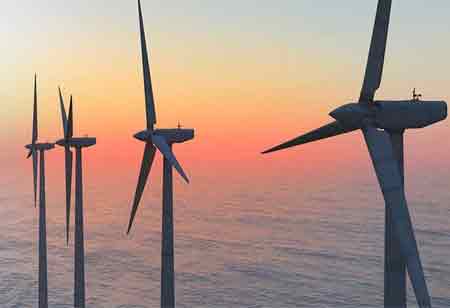Thank you for Subscribing to Electrical Business Review Weekly Brief
I agree We use cookies on this website to enhance your user experience. By clicking any link on this page you are giving your consent for us to set cookies. More info
Next-Generation Technologies in Electrical Power Transmission
Innovative technologies in electrical power transmission enhance efficiency, reliability, and sustainability, supporting renewable integration while minimising environmental impact and paving the way for a resilient energy future.

By
Electrical Business Review | Wednesday, October 30, 2024
Stay ahead of the industry with exclusive feature stories on the top companies, expert insights and the latest news delivered straight to your inbox. Subscribe today.
Innovative technologies in electrical power transmission enhance efficiency, reliability, and sustainability, supporting renewable integration while minimising environmental impact and paving the way for a resilient energy future.
FREMONT CA: Electrical power transmissions are poised to transform the energy landscape by enhancing power delivery systems' efficiency, reliability, and sustainability. Innovations such as high-voltage direct current (HVDC) technology, smart grids, and advanced materials are reshaping how electricity is transmitted over long distances and integrated with renewable energy sources. These technologies facilitate real-time monitoring and management of the grid, allowing for improved load balancing and reduced energy losses. Developments in energy storage systems and automation are enabling a more flexible and resilient power infrastructure capable of meeting the growing demand for electricity while minimising environmental impact.
Below are some of the emerging technologies in electrical power transmission:
High-voltage Direct Current Transmission
High-voltage direct current (HVDC) systems offer energy-efficient solutions with reduced line losses over long distances compared to traditional transmission methods. These systems are particularly suited for cross-country and underwater applications, functioning at high voltage levels. HVDC technology enables the connection of grids with varying frequencies, allowing for power exchange across regions. Enhanced grid stability is achieved through controllable power flows, which mitigate blackout risks and support the integration of renewable energy sources.
Flexible AC Transmission Systems
Flexible AC transmission systems enhance voltage control and power flow management within the electrical grid. These systems regulate voltage levels and optimise power distribution by utilising advanced devices. This technology can prevent overloads and alleviate congestion in the grid, increasing the capacity of existing transmission lines without significant infrastructure investment. Furthermore, it facilitates the integration of renewable energy sources while minimising environmental impact.
Superconducting Cables
Superconducting cables are designed to eliminate energy losses during power transmission by leveraging superconductive materials. These cables enhance reliability due to their resistance to overheating and degradation. Ongoing advancements in related technologies are decreasing operational costs, making superconducting solutions increasingly feasible for urban applications where space is at a premium.
Dynamic Line Rating
Dynamic line rating (DLR) technology adjusts the rating of electrical conductors in real time based on environmental conditions. This approach optimises the capacity of existing transmission lines, enhancing their efficiency and lifespan. DLR systems maximise the utilisation of current assets, reducing the need for new infrastructure. Additionally, they improve grid reliability by adapting to fluctuations in demand and supply.
Advanced Grid Storage Solutions
Large-scale energy storage solutions are crucial in maintaining grid stability by providing services such as frequency regulation. These systems support the integration of renewable energy sources, balancing supply and demand by storing excess energy for later use. Such storage technologies also reduce reliance on traditional peaking power plants, contributing to cost efficiency in energy management.
Wireless Power Transmission
Wireless power transmission systems employ innovative techniques to deliver power without physical connections. These systems are suitable for remote locations and have potential applications in various fields, including electric vehicle charging and powering drones. The lack of extensive physical infrastructure associated with these technologies leads to lower installation and maintenance costs while enhancing safety and efficiency.
Power Electronics and Solid-State Transformers
Power electronics and solid-state transformers facilitate precise power flow control in distribution systems. By improving the efficiency of power conversion, these technologies support the integration of renewable energy sources. The compact design of solid-state transformers allows for easier installation and contributes to overall system reliability.
High-Temperature Superconductors
High-temperature superconductors enhance power transmission capacity and operational reliability. These systems operate at higher temperatures than traditional superconductors, simplifying cooling requirements. Their design is well-suited for urban environments, contributing to a reduced environmental footprint.
Advanced Conductor Materials
Recent advancements in conductor materials have led to the development of options that offer improved electrical performance and reduced resistive losses. These innovative materials enhance overall transmission efficiency while providing environmentally friendly alternatives to conventional options. Their use signals a shift towards more sustainable power transmission methods.
As energy storage solutions and wireless transmission methods gain traction, they offer innovative alternatives for meeting the growing electricity demand while minimising environmental impact. The development of advanced materials further supports this transition towards a more sustainable power infrastructure. Collectively, these innovations are paving the way for a future where power transmission is more effective and aligned with global sustainability goals, ensuring a resilient energy system for future generations.








